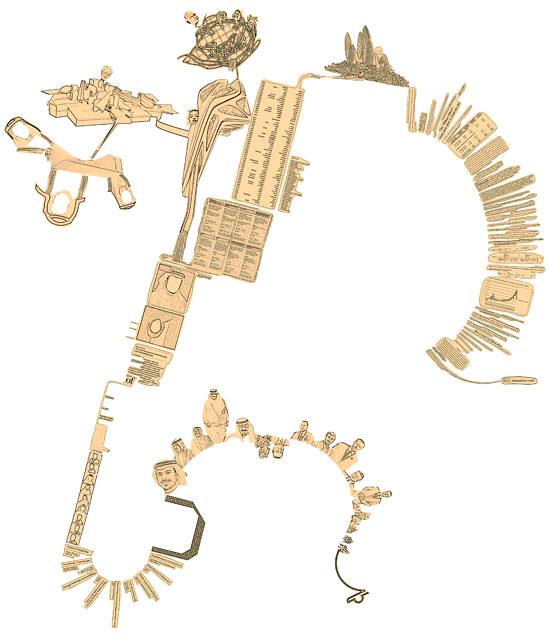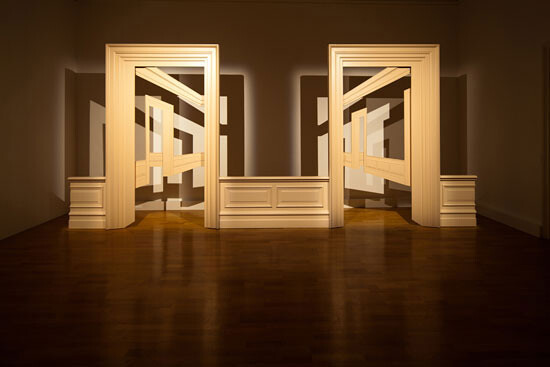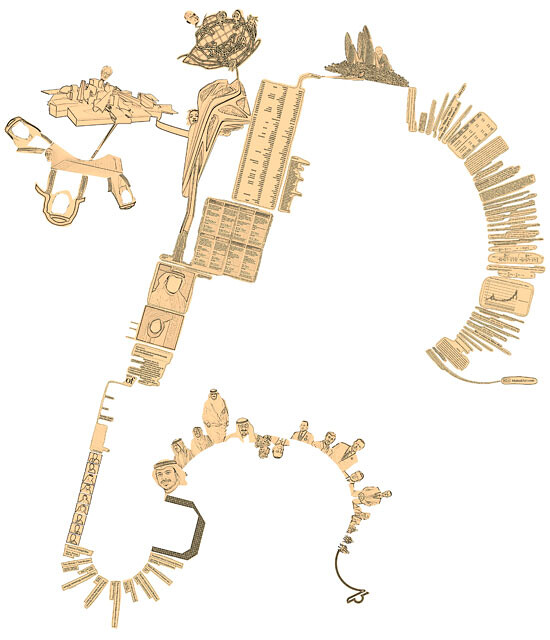Continued from “Walkthrough, Part I”
During the past decade or so, I’ve been hearing more and more about Arab artists, about contemporary Arab art, modern Arab art, Islamic art, Middle Eastern art, its makers, sponsors, consumers, genres, and histories.
I’ve also been fascinated by the increasing number of festivals, workshops, museums, galleries, residencies, exhibitions, prizes, foundations, schools, and journals emerging in Arab cities such as Beirut, Doha, Cairo, Alexandria, Marrakech, Tangiers, Ramallah, Sharjah, and especially the United Arab Emirates—the UAE.
The UAE, in fact, presents a fascinating case study.
The UAE (and I apologize if I repeat here some of the dumb facts you already know) is composed of seven emirates (Abu Dhabi, Ajman, Dubai, Fujairah, Ras al-Khaimah, Sharjah, and Umm al-Quwain). Abu Dhabi is the capital of the UAE, and in terms of resources and wealth, it is also the richest of the seven emirates. Just to give you a sense of its wealth: The UAE holds between 3 and 5 percent of the world’s proven natural gas reserves, at around 215 trillion cubic feet, which is the seventh largest natural gas deposit in the world. Ninety-four percent of these reserves are in Abu Dhabi.
The UAE also has between 6 and 9 percent of the world’s proven oil reserves. That’s the seventh largest in the world at around 97.8 billion barrels, and it is important to note that 94 percent of those reserves are in Abu Dhabi. At an average price of $110 per barrel of oil, Abu Dhabi netted $120 billion from oil in 2012.
Abu Dhabi also has the third largest (after Norway and Saudi Arabia) sovereign wealth fund in the world, valued at around $630 billion. This sovereign wealth fund generates loads of dollars for the emirate every year. It has a twenty-year annual rate of return of around 6.9 percent, and a thirty-year annual rate of return of 8.1 percent.
In other words, Abu Dhabi is not just rich. It is very, very rich.
But Abu Dhabi also seems to know that its wealth depends too much on petro-chemical products. In the past two decades or so, Abu Dhabi has tried to diversify its hydrocarbon-dominated economy. It has invested heavily in aerospace, health care, biomedical technology, education, finance, and as you may have heard, in culture and the arts.
The main investment in culture and the arts is the well-publicized Saadiyat Island: a twenty-seven-square-kilometer island (that’s half the size of Bermuda) where Abu Dhabi has planned a $27 billon development project. On this one island, Abu Dhabi is about to build the largest-to-date Guggenheim Museum, to be designed by Frank Gehry. The same island will have a Louvre Abu Dhabi museum designed by Jean Nouvel. The same island will have a Sheikh Zayed National Museum designed by Foster and Partners. Saadiyat Island will also host a Maritime Museum designed by Tadao Ando, a performing arts center designed by Zaha Hadid, a New York University campus designed by Rafael Vinoly, a few marinas, seven-star hotels, restaurants, golf courses, and so on. We know how such islands are erected.
But it is also important to note that Abu Dhabi is not just hiring starchitects to build cultural meccas that the emirate will then fill with high-end, market-tested Arab, Iranian, Turkish, Islamic, North African, and Southeast Asian art in the hope that this alone will attract millions of tourists. No. Abu Dhabi plans a broad infrastructure that will not only include museums, universities, and colleges, but also art magazines, art journals, art prizes, art foundations, private and public art collections, art handlers, insurers, writers, critics, galleries, archives, and so on, and so on. And Abu Dhabi is also well-aware that when students come to study at NYU and the other colleges, they will likely bring with them alternative lifestyles and cultures. As such, I was not surprised to meet someone who had been charged with designing Abu Dhabi’s alternative arts scene.


I must say that all of this, for me as an artist, an Arab, or even as an American, is truly fascinating. How long have we been waiting for an Arab government to actually spend its wealth on art, education, health care and culture? It is happening today. And not just in Abu Dhabi. This is happening in Qatar, Saudi Arabia, Kuwait, and to a lesser extent, in other Arab states as well.
But then every time you ask the question: Why are these sheikhs and sheikhas in the Gulf all of a sudden so interested in the arts? Why are they all of a sudden spending all this money on culture and the arts? Every time you ask this question, you should also be ready to hear the two dominant and weighty caricatures that have emerged to make sense of all this.
The first caricature states that all this investment in culture and the arts in the Arabian/Persian Gulf is a cynical move undertaken by a bunch of autocrats seeking to shift their economies away from petrochemical dependence and towards tourism, all the while camouflaging and veiling their stay-in-power-longer, get-even-richer schemes under the “civilizing” cloak of culture.
Moreover, this sudden love of the arts and culture by the Emirati sheikhs and sheikhas simply aims to curry favor with restless and suspicious foreign powers such as France, the UK, and the US—powers whose protection will surely be needed should things get out of hand with a nuclear-armed Iran.
In other words, the sheikhs and sheikhas in Abu Dhabi and Qatar don’t give a damn about the arts. They only care about more power and more money. And if, in the midst of their negotiations with the French government for some Mirage fighter jets and military bases, they need to add a Louvre, then so be it. What’s a billion dollars for a Louvre? This is, by the way, what the government of Abu Dhabi agreed to pay the French government in order to license the Louvre brand for thirty years—$1 billion. What’s a billion dollars for the government of Abu Dhabi? It’s a small fraction of the interest earned by their sovereign wealth fund annually. It’s Emirati pocket change.
The second caricature states that there is nothing cynical in all of this spending. In fact, it says that all of this investment in the arts and culture is the sign of an Arab renaissance, of young new rulers seeking to assert the complexity and diversity of Arab, Islamic, and Emirati values, especially after 9/11.
We are told that this renaissance is led by Western-bred visionaries who are tired of the old ways, and who are wholeheartedly trying to first democratize the taste of their subjects via the arts, and then they will democratize all aspects of civil and political life in their intellectually thirsty but socially conservative lands.
Yes, they may be licensing Western brands such as the Louvre and the Guggenheim, but let’s give these leaders a break. We should give them a break for no other reason than that we know very well that these are the same people who only a few years ago would have spent their petro-dollars buying more Ferraris and Bentleys than they could drive; these are the same people who only a few years ago were buying yet more high-end properties in New York, London, Tokyo, and Paris; these are the same people who only a few years ago would have invested most if not all of their wealth in foreign lands, but who are today investing in culture and health care and education, and most importantly, who are doing all this investment at home; and they are, after all, only trying to do in ten or twenty years in the twenty-first century what it took their Western counterparts one hundred years to put in place in the nineteenth and twentieth centuries.
Who established the Metropolitan Museum of Art after all? Was it not robber barons? Let’s call them American sheikhs. Was it not American sheikhs who established the Met over one hundred years ago, and who helped shift the center of modern art from Paris to New York seventy years ago? Why can’t Arab sheikhs do the same for Arab culture today? They may not shift the center of the contemporary art world to the East, but at least they will certainly establish an eastern outpost for it there.
I must say that I don’t care to sort through these caricatures, and I don’t care to find out whether the sheikhs and sheikhas in Abu Dhabi and Qatar are enlightened, sincere, or cynical. I assume these are complex people, and like all complex people, they make contradictory decisions. I assume that they are sincere, cynical, and enlightened at the same time. I don’t know. In fact, I am quite sure that I will never know.


But there is one thing that I do know for sure—one thing about which I am absolutely certain.
At the opening of the Guggenheim Museum in Abu Dhabi, or Qatar, or elsewhere in the Gulf, sometime between 2017 and 2024, a proud local resident rushes the entrance only to find that he is unable to proceed. Why can’t he proceed? Why doesn’t he go in?
Is it because he is dressed in jeans and a black t-shirt and sneakers, and this is a black-tie affair? He feels underdressed. Is this why he does not go in? No.
It must be the thugs who are shielding the ruling dynasty, a ruling class that is attending the event en masse to showcase its benevolence and refined sensibilities, pubescent-future-rulers in tow. Do the thugs prevent his access? No.
He simply feels that if he walked in, he would certainly “hit a wall.” That he would literally hit a wall.
On the spot, he turns to face the onrushing crowd and screams: “Stop. Don’t go in. Be careful!”
Within seconds, the security services arrive. They beat him severely, handcuff him, and send him to a psychiatric facility.
The very next day, I open the newspaper, turn to page six, and look at the bottom right-hand corner. I read the following headline: “Demented Man Disturbs Opening: Claims World Is Flat.”
This event has already happened. This headline has already been written. About this, I am absolutely certain.
Category
This text is (here and there) a work of fiction. Names, characters, places, and incidents either are products of the author’s imagination or are used fictitiously. Any resemblance to actual events or locales or persons, living or dead, is entirely coincidental. The text transcribes the walkthrough/presentation component of Walid Raad’s exhibition Scratching on Things I Could Disavow, recently presented at dOCUMENTA (13) in Kassel.

